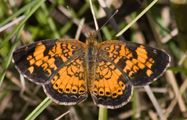Native Plants
Search for native plants by scientific name, common name or family. If you are not sure what you are looking for, try the Combination Search or our Recommended Species lists.
Symphyotrichum novae-angliae
Symphyotrichum novae-angliae (L.) G.L. Nesom
New England Aster, New England American-aster
Asteraceae (Aster Family)
Synonym(s): Aster novae-angliae, Lasallea novae-angliae, Virgulus novae-angliae
USDA Symbol: SYNO2
USDA Native Status: L48 (N), CAN (N)
New England American-aster is large and showy, growing to 6 or more ft. in height. The perennialís hairy, clasping leaves are arranged densely on its stout stems. Showy, bright, rose-purple flowers with orange-yellow centers bloom in profusion at the tips of the leafy branches.
The flower color is variable, ranging from lavender to blue to white. A pink variety of this species is sometimes grown commercially.
Plant Characteristics
Duration: PerennialHabit: Herb
Size Notes: Up to about 6 feet tall.
Fruit: Fruit is a cypsela (pl. cypselae). Though technically incorrect, the fruit is often referred to as an achene.
Bloom Information
Bloom Color: Pink , Yellow , PurpleBloom Time: Aug , Sep , Oct , Nov
Distribution
USA: AL , AR , CO , CT , DC , DE , GA , IA , IL , IN , KS , KY , MA , MD , ME , MI , MN , MO , MS , MT , NC , ND , NE , NH , NJ , NM , NY , OH , OK , OR , PA , RI , SC , SD , TN , UT , VA , VT , WA , WI , WV , WYCanada: BC , MB , NB , NS , ON , QC
Native Distribution: Que. & ME to SC, w. to e. Great Plains; also mts. of WY, CO & NM; naturalized elsewhere
Native Habitat: Moist, open, wooded areas; meadows; mesic prairies; disturbed sites; stream banks
Growing Conditions
Light Requirement: Part ShadeSoil Moisture: Moist
Soil pH: Acidic (pH<6.8)
Soil Description: Moist soils.
Conditions Comments: New England aster flowers until frost. Its roots should be divided every several years to keep the plant growing vigorously. Can be aggressive.
Seen with Goldenrods in old fields undergoing natural succession. Source of several cultivars. (Ontario Native Plants 2002)
Benefit
Use Wildlife: Bees and butterflies frequent this wildflower. Nectar source for Monarch butterflies.Conspicuous Flowers: yes
Attracts: Butterflies
Larval Host: Pearl Crescent (Phyciodes tharos)and checkerspot butterflies.
Nectar Source: yes
Value to Beneficial Insects
Special Value to Native BeesSpecial Value to Bumble Bees
Special Value to Honey Bees
This information was provided by the Pollinator Program at The Xerces Society for Invertebrate Conservation.
Butterflies and Moths of North America (BAMONA)
|
Pearl Crescent (Phyciodes tharos)  Larval Host |
Propagation
Description: Sow seeds, 5/8" deep, outside in fall or provide cold stratification. New England aster can also be propagated by "softwood" cuttings taken in late spring. Mature plants can be divided in the spring by sectioning off individual stems with their associatSeed Collection: The seed heads remain intact for several weeks after the first frost. At that time, shade the nutlets loose or pluck them from the head. Air-dry and store in sealed, refrigerated containers.
Seed Treatment: This species requires or benefits from a three month period of cold-moist stratification in the refrigerator. Damp stratify 4-6 weeks prior to planting.
Commercially Avail: yes
Mr. Smarty Plants says
Native wildflowers for Northern Indiana
May 08, 2007
I had the wonderful opportunity to visit the Lady Bird Johnson Wildflower Center
on Saturday April 21. What a beautiful place. I thoroughly enjoyed my visit. I was
wondering how I could find out w...
view the full question and answer
National Wetland Indicator Status
| Region: | AGCP | AK | AW | CB | EMP | GP | HI | MW | NCNE | WMVE |
| Status: | FACW | FACW | FACW | FACW | FACW | FACW | FACW |
From the National Organizations Directory
According to the species list provided by Affiliate Organizations, this plant is on display at the following locations:Native Plant Center at Westchester Community College, The - Valhalla, NY
Delaware Nature Society - Hockessin, DE
Mt. Cuba Center - Hockessin, DE
Bibliography
Bibref 1186 - Field Guide to Moths of Eastern North America (2005) Covell, C.V., Jr.Bibref 1185 - Field Guide to Western Butterflies (Peterson Field Guides) (1999) Opler, P.A. and A.B. Wright
Bibref 1620 - Gardening with Native Plants of the South (Reprint Edition) (2009) Wasowski, S. with A. Wasowski
Bibref 946 - Gardening with Prairie Plants: How to Create Beautiful Native Landscapes (2002) Wasowski, Sally
Bibref 1294 - The Midwestern Native Garden: Native Alternatives to Nonnative Flowers and Plants An Illustrated Guide (2011) Adelman, Charlotte and Schwartz, Bernard L.
Search More Titles in Bibliography
Web Reference
Webref 38 - Flora of North America (2019) Missouri Botanical Garden, St. Louis, MO & Harvard University Herbaria, Cambridge, MA.Webref 23 - Southwest Environmental Information Network (2009) SEINet - Arizona Chapter
From the Archive
Wildflower Newsletter 1989 VOL. 6, NO.4 - Spring Climbs Rockies Slowly, Colorado Cooler, Conference of Wildflower and Nati...Additional resources
USDA: Find Symphyotrichum novae-angliae in USDA PlantsFNA: Find Symphyotrichum novae-angliae in the Flora of North America (if available)
Google: Search Google for Symphyotrichum novae-angliae
Metadata
Record Modified: 2023-01-20Research By: TWC Staff